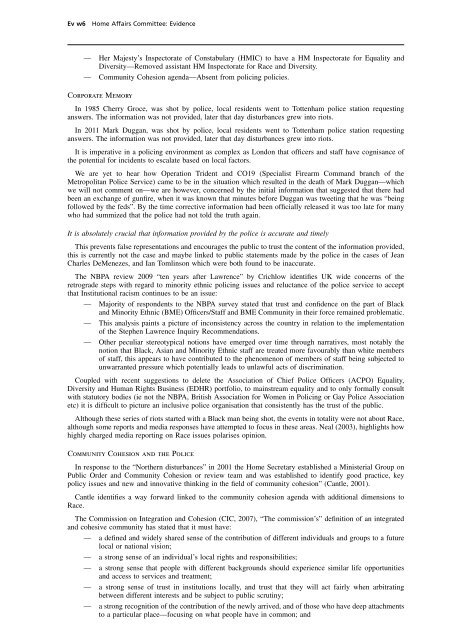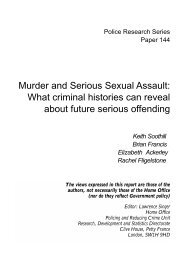Policing Large Scale Disorder: Lessons from the disturbances of ...
Policing Large Scale Disorder: Lessons from the disturbances of ...
Policing Large Scale Disorder: Lessons from the disturbances of ...
Create successful ePaper yourself
Turn your PDF publications into a flip-book with our unique Google optimized e-Paper software.
Ev w6 Home Affairs Committee: Evidence<br />
— Her Majesty’s Inspectorate <strong>of</strong> Constabulary (HMIC) to have a HM Inspectorate for Equality and<br />
Diversity—Removed assistant HM Inspectorate for Race and Diversity.<br />
— Community Cohesion agenda—Absent <strong>from</strong> policing policies.<br />
Corporate Memory<br />
In 1985 Cherry Groce, was shot by police, local residents went to Tottenham police station requesting<br />
answers. The information was not provided, later that day <strong>disturbances</strong> grew into riots.<br />
In 2011 Mark Duggan, was shot by police, local residents went to Tottenham police station requesting<br />
answers. The information was not provided, later that day <strong>disturbances</strong> grew into riots.<br />
It is imperative in a policing environment as complex as London that <strong>of</strong>ficers and staff have cognisance <strong>of</strong><br />
<strong>the</strong> potential for incidents to escalate based on local factors.<br />
We are yet to hear how Operation Trident and CO19 (Specialist Firearm Command branch <strong>of</strong> <strong>the</strong><br />
Metropolitan Police Service) came to be in <strong>the</strong> situation which resulted in <strong>the</strong> death <strong>of</strong> Mark Duggan—which<br />
we will not comment on—we are however, concerned by <strong>the</strong> initial information that suggested that <strong>the</strong>re had<br />
been an exchange <strong>of</strong> gunfire, when it was known that minutes before Duggan was tweeting that he was “being<br />
followed by <strong>the</strong> feds”. By <strong>the</strong> time corrective information had been <strong>of</strong>ficially released it was too late for many<br />
who had summized that <strong>the</strong> police had not told <strong>the</strong> truth again.<br />
It is absolutely crucial that information provided by <strong>the</strong> police is accurate and timely<br />
This prevents false representations and encourages <strong>the</strong> public to trust <strong>the</strong> content <strong>of</strong> <strong>the</strong> information provided,<br />
this is currently not <strong>the</strong> case and maybe linked to public statements made by <strong>the</strong> police in <strong>the</strong> cases <strong>of</strong> Jean<br />
Charles DeMenezes, and Ian Tomlinson which were both found to be inaccurate.<br />
The NBPA review 2009 “ten years after Lawrence” by Crichlow identifies UK wide concerns <strong>of</strong> <strong>the</strong><br />
retrograde steps with regard to minority ethnic policing issues and reluctance <strong>of</strong> <strong>the</strong> police service to accept<br />
that Institutional racism continues to be an issue:<br />
— Majority <strong>of</strong> respondents to <strong>the</strong> NBPA survey stated that trust and confidence on <strong>the</strong> part <strong>of</strong> Black<br />
and Minority Ethnic (BME) Officers/Staff and BME Community in <strong>the</strong>ir force remained problematic.<br />
— This analysis paints a picture <strong>of</strong> inconsistency across <strong>the</strong> country in relation to <strong>the</strong> implementation<br />
<strong>of</strong> <strong>the</strong> Stephen Lawrence Inquiry Recommendations.<br />
— O<strong>the</strong>r peculiar stereotypical notions have emerged over time through narratives, most notably <strong>the</strong><br />
notion that Black, Asian and Minority Ethnic staff are treated more favourably than white members<br />
<strong>of</strong> staff, this appears to have contributed to <strong>the</strong> phenomenon <strong>of</strong> members <strong>of</strong> staff being subjected to<br />
unwarranted pressure which potentially leads to unlawful acts <strong>of</strong> discrimination.<br />
Coupled with recent suggestions to delete <strong>the</strong> Association <strong>of</strong> Chief Police Officers (ACPO) Equality,<br />
Diversity and Human Rights Business (EDHR) portfolio, to mainstream equality and to only formally consult<br />
with statutory bodies (ie not <strong>the</strong> NBPA, British Association for Women in <strong>Policing</strong> or Gay Police Association<br />
etc) it is difficult to picture an inclusive police organisation that consistently has <strong>the</strong> trust <strong>of</strong> <strong>the</strong> public.<br />
Although <strong>the</strong>se series <strong>of</strong> riots started with a Black man being shot, <strong>the</strong> events in totality were not about Race,<br />
although some reports and media responses have attempted to focus in <strong>the</strong>se areas. Neal (2003), highlights how<br />
highly charged media reporting on Race issues polarises opinion.<br />
Community Cohesion and <strong>the</strong> Police<br />
In response to <strong>the</strong> “Nor<strong>the</strong>rn <strong>disturbances</strong>” in 2001 <strong>the</strong> Home Secretary established a Ministerial Group on<br />
Public Order and Community Cohesion or review team and was established to identify good practice, key<br />
policy issues and new and innovative thinking in <strong>the</strong> field <strong>of</strong> community cohesion” (Cantle, 2001).<br />
Cantle identifies a way forward linked to <strong>the</strong> community cohesion agenda with additional dimensions to<br />
Race.<br />
The Commission on Integration and Cohesion (CIC, 2007), “The commission’s” definition <strong>of</strong> an integrated<br />
and cohesive community has stated that it must have:<br />
— a defined and widely shared sense <strong>of</strong> <strong>the</strong> contribution <strong>of</strong> different individuals and groups to a future<br />
local or national vision;<br />
— a strong sense <strong>of</strong> an individual’s local rights and responsibilities;<br />
— a strong sense that people with different backgrounds should experience similar life opportunities<br />
and access to services and treatment;<br />
— a strong sense <strong>of</strong> trust in institutions locally, and trust that <strong>the</strong>y will act fairly when arbitrating<br />
between different interests and be subject to public scrutiny;<br />
— a strong recognition <strong>of</strong> <strong>the</strong> contribution <strong>of</strong> <strong>the</strong> newly arrived, and <strong>of</strong> those who have deep attachments<br />
to a particular place—focusing on what people have in common; and
















